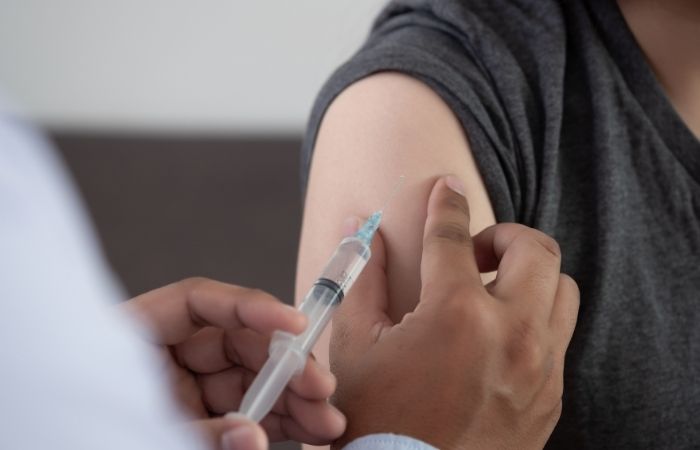Can You Get Genital Herpes on Your Face? The Truth About HSV Types
Quick Answer: HPV in men can cause visible genital warts, throat irritation, or no symptoms at all. You can have and spread HPV without knowing, even if you never see a bump.
The Catch: HPV Often Has No Visible Symptoms in Men
The most common strain of Human Papillomavirus (HPV) in men doesn’t show up as anything you can see or feel. In fact, the CDC estimates that most sexually active men will contract HPV at some point in their lives, often without ever knowing it happened.
Some HPV strains do cause warts, usually around the genitals, anus, or groin. Others infect the mouth and throat. But many types are “silent,” meaning you can carry and transmit the virus without symptoms. That’s where the confusion begins, and why many men don’t get tested, even if they’re at risk.
This silence doesn’t make it harmless. In rare cases, certain high-risk strains of HPV can lead to penile, anal, or oropharyngeal cancer, especially when combined with smoking or a weakened immune system. But most HPV infections go away on their own within two years.
If you’ve recently noticed a bump, or if you haven’t but feel like something’s off, keep reading. We’ll walk you through what HPV can look like in men, how to tell the difference between common skin conditions and something more serious, and when it’s time to test.

People are also reading: What If You Test Too Soon for Gonorrhea? The Truth About False Negatives
Genital Warts: What They Look Like (And Don’t)
Genital warts caused by low-risk HPV strains are one of the few visible signs men might notice. But they’re easy to miss, or misidentify.
In men, HPV warts often appear on:
- Penis shaft or head
- Scrotum
- Inner thighs or groin
- Around the anus (even without anal sex)
They may be:
- Flesh-toned or slightly pink
- Flat or raised
- Single bumps or clusters (sometimes called “cauliflower-like”)
- Painless and not itchy, though irritation can occur if rubbed or shaved
What makes HPV tricky is that these warts can look identical to skin tags, ingrown hairs, or even Fordyce spots (harmless sebaceous glands). And while warts are often soft and moist, they don’t always follow the rules.
Take Jordan, 29. He found a small bump near his groin after switching razors. He assumed it was an ingrown hair. It didn’t hurt, so he ignored it. Six months later, his doctor confirmed it was a wart from HPV.
“I felt stupid. I had no idea it could look like that,”
Don’t feel stupid. Feel informed. If something shows up and stays more than a few weeks, or grows, get it looked at or tested.
Oral HPV: When the Virus Hides in the Throat
It’s not just below the belt. Oral HPV is becoming more common, especially among men who engage in oral sex. And unlike genital HPV, the symptoms here can be even more invisible, until they’re not.
High-risk strains of HPV (especially HPV-16) have been linked to oropharyngeal cancers, which affect the back of the throat, base of the tongue, and tonsils. According to the American Cancer Society, men are up to five times more likely than women to develop HPV-related throat cancer.
Signs of oral HPV may include:
- Persistent sore throat or hoarseness
- Lumps or lesions on the tonsils or back of the tongue
- Ear pain or difficulty swallowing
- Chronic cough
But here’s the kicker: many of these symptoms show up only after cancer has developed. That’s why early detection, and routine screening when possible, is so important, especially if you smoke or have a high number of oral sex partners.
There is no FDA-approved test for oral HPV in men, but if you’re worried, speak to your doctor about symptoms or suspicious throat changes.
Skin Tag or HPV? Why So Many Men Get This Wrong
One of the most common DMs health clinics get from men goes like this: “I have this little flap of skin near my groin, could it be an STD?” It’s not paranoia. The fear is real, and so is the confusion. That’s because HPV warts can mimic harmless skin tags, especially in men with no other symptoms.
Here’s the tricky part: there’s no visual test for HPV. Even doctors sometimes need a biopsy or dermatoscope to confirm. Still, there are some clues you can watch for:
Figure 1. Visual differences between skin tags and HPV-related warts in men. Always consult a clinician for confirmation.
It’s normal to misread your skin, especially in areas you don’t inspect closely. But don’t rely on guesswork. If a bump shows up after unprotected sex, stays longer than two weeks, or starts multiplying, you deserve an accurate answer.
HPV Without Warts: Yes, It’s Still a Thing
Not seeing a wart doesn’t mean you’re in the clear. In fact, most people with HPV don’t get warts at all. The immune system usually clears the virus within 6 to 24 months. But during that window, you can still pass it to others.
Many men only discover they have HPV when a partner is diagnosed. It’s common to hear phrases like,
“But I never had symptoms,” or “We always used condoms.”
Unfortunately, condoms only reduce risk, they don’t eliminate it entirely. That’s because HPV spreads through skin-to-skin contact, especially in areas not covered by condoms (like the base of the penis, scrotum, or mouth).
Case in point: Antonio, 35, thought he was being safe. He always used condoms. His girlfriend tested positive for HPV during a Pap smear. Antonio had no visible symptoms and assumed she must have gotten it elsewhere, until his doctor explained the nature of HPV transmission.
“I felt betrayed,” he said, “but then I realized how little I actually knew.”
If you’re in a new relationship or someone tells you they tested positive, you may already carry HPV, even if there’s nothing to see. Testing or vaccination could still help guide your next steps.
Testing for HPV in Men: What’s the Deal?
Let’s clear something up: there is no routine FDA-approved HPV test for men like there is for women. That doesn’t mean you're helpless. It just means you’ll need to be strategic.
Testing is usually limited to:
- Visual exams by a clinician for warts or lesions
- Anal Pap smears for men who have sex with men or are immunocompromised
- Biopsies or scoping for suspicious throat or skin growths
At-home STD kits do not currently include HPV testing for men, but they can rule out co-infections like herpes, syphilis, or gonorrhea, which may present with similar bumps or irritation.
If you’re feeling anxious or uncertain, an at-home combo kit can help eliminate other concerns while you talk to a provider about HPV. This discreet combo test checks for multiple infections in one go, without needing to visit a clinic.
Testing isn’t just about peace of mind. It’s about not passing along something silently.

People are also reading: Can You Get an STD Even If You Use a Condom?
When HPV Becomes Throat Cancer: Know the Signs
We need to talk about HPV-related oropharyngeal cancer. It doesn’t happen often, but when it does, it hits men hardest. HPV-16 is the culprit in more than 70% of these cancers. And unlike other cancers, it’s often diagnosed late because early symptoms are vague or non-existent.
What to watch for:
- Lump in the neck or persistent swollen lymph nodes
- Sore throat that doesn’t go away
- Hoarseness or voice changes
- White or red patches in the mouth
- Unexplained weight loss or fatigue
While you can’t swab your throat for HPV at home, you can advocate for yourself. If something feels wrong, especially after oral exposure, speak up. Your voice might be the only early warning system you have.
CDC data shows HPV-related throat cancers are rising steadily in men. And yet, many still think HPV is only a “woman’s issue.” It’s not.
Early detection saves lives, even if there’s nothing to see yet.
What If Your Partner Tests Positive but You Have No Symptoms?
This is one of the most common, and most stressful, scenarios. You’re sitting across from your partner, and they say the words: “I tested positive for HPV.” You do a mental scan of your body: no warts, no sores, no throat pain. Are you in the clear? Should you get tested? Should you avoid sex?
First, breathe. This doesn’t mean someone cheated. HPV can live in your system for months or years without causing symptoms. It can be passed through vaginal, anal, or oral sex, even if protection was used. Many people contract HPV from partners who never knew they had it.
Second, understand that there’s no test to “clear” you of HPV. Unless you have visible symptoms, you likely won’t get a definitive answer. That’s why prevention (like the vaccine) and mutual honesty matter so much.
Ben, 32, shared this:
“When my girlfriend told me she had HPV, I froze. I felt dirty, even though I had no symptoms. A nurse told me I might have given it to her years ago without knowing. That hit me hard.”
If your partner’s test is recent, talk to a provider about screening options for you, especially if you're immunocompromised or engage in receptive anal or oral sex. And while you can't remove the virus yourself, you can reduce transmission risk and keep an eye out for emerging symptoms.
When to See a Doctor (Even If You’re Not Sure)
Figure 2. When to seek medical evaluation for possible HPV symptoms, even if you don’t have a full outbreak.
Clinicians can use scopings, acetic acid (vinegar), or biopsy instruments to investigate suspect spots themselves. They'll suggest what's next if anything does concern them. CDC recommendations also support follow-up with those at increased risk factors.
If you're unsure what you're dealing with, at-home STD testing is a smart first step. STD Test Kits offers discreet, fast options you can use without leaving home.
Can Men Get the HPV Vaccine? (Yes, And You Should)
Here’s the part most people wish they knew sooner: the HPV vaccine isn’t just for teens or women. It’s for anyone who wants to reduce their cancer risk and protect their partners, yes, even grown men.
The vaccine, known as Gardasil 9, protects against nine common HPV strains, including the ones most likely to cause genital warts and throat cancer. It’s approved for people up to age 45, and you can still benefit even if you’ve already had HPV.
Who should consider it?
- Men under 45 who have never been vaccinated
- Anyone with multiple partners or changing partners
- Men who have sex with men
- People living with HIV or other immune issues
The catch? Many adult men were never offered the vaccine in adolescence. If that’s you, it’s not too late. One short series of injections could reduce your cancer risk dramatically. The CDC confirms that adult vaccination is safe and can still offer protection. Talk to your provider, or a local pharmacy, about availability.

People are also reading: The Numbers Don’t Lie Why Non-Sex Workers Often Have Higher Undiagnosed STD Rates
FAQs
1. Can I have HPV even if I’ve never had a single symptom?
Yep, welcome to the frustrating truth. Most men with HPV never get warts, lesions, or any visible clue. You can carry it, spread it, and still feel completely fine. It’s not rare, it’s actually the norm. That’s what makes it tricky and why so many people unknowingly pass it on.
2. What do HPV warts really look like?
Think soft, flesh-toned bumps, sometimes flat, sometimes bumpy like tiny cauliflower florets. They might hang out solo on your shaft or scrotum, or pop up in clusters near your groin or anus. No pain, no drama, just... there. And yeah, they’re easy to mistake for a skin tag or razor bump. That’s why people miss them.
3. Could that tickle in my throat be HPV?
If it’s been lingering, maybe. If you’ve had oral sex and feel something off, like a weird lump in your throat, a sore that won’t quit, or a change in your voice, it’s worth getting checked out. HPV-16 doesn’t usually ring the alarm early. But when it does, it’s whispering through symptoms like these. Don’t ignore them.
4. How soon after exposure would symptoms show, if they show at all?
That’s the wild part. HPV can take weeks, months, even years to show up, if it ever does. There’s no standard timeline. You could’ve gotten it years ago and only find out when your partner gets diagnosed during a Pap smear.
5. Can I actually get tested for HPV as a guy?
Not in the way you’re hoping. There’s no FDA-approved swab or blood test for HPV in men, unless you're doing an anal Pap for high-risk groups. If you’ve got visible warts, a clinician might diagnose based on appearance or biopsy. Otherwise, it's a waiting game or a conversation with your doc.
6. Is it possible I gave HPV to my partner and didn’t know it?
Totally. And it doesn’t mean you cheated or did anything wrong. HPV can hang out silently for years. Plenty of couples pass it back and forth without realizing it. It’s frustrating, but it’s also a reason to talk honestly and move forward together.
7. Does the HPV vaccine still work if I’m over 26?
Yes. The vaccine’s approved up to age 45, and even if you’ve had one strain, it can still protect you from others. It’s like installing a better firewall, even if you’ve already had a security breach. Especially useful if you’re dating again or have multiple partners.
8. Will condoms protect me from HPV?
They help, but they’re not a force field. HPV spreads through skin-to-skin contact, not just fluids. That means it can live on areas condoms don’t cover: the base of the penis, scrotum, even inner thighs. So yes, use them, but know they’re not bulletproof for this one.
9. Can HPV go away on its own?
Often, yes. Your immune system usually clears it in 6 to 24 months. You might never know it came and went. But high-risk strains? They can hang around, and that’s when cancer risk creeps in. That’s why it pays to stay on top of your health, even when you feel fine.
10. I found a bump. Should I freak out?
No freaking needed. But don’t ignore it either. If it’s new, doesn’t go away in a couple of weeks, or starts multiplying, it’s worth a check. Whether it’s HPV, herpes, or something totally harmless, you deserve to know. You’re not paranoid, you’re proactive.
Your Next Step: Test, Talk, or Wait?
If you’ve made it this far, you’re already ahead of most guys. You’re asking questions, checking your body, and looking for real answers. That’s a big deal, because most men don’t even know they can get HPV, let alone pass it on.
Here’s what to consider:
- See something? Get it checked. A bump that doesn’t go away is worth a medical eye, even if it’s not painful.
- Nothing visible, but worried? Consider a full STD panel to rule out other infections and talk to your provider about your HPV risk.
- In a relationship? Start the conversation early. Testing and vaccination protect both of you.
And if you're feeling the mental spiral of “what if,” don’t wait to calm that storm. This test kit can’t diagnose HPV, but it can rule out many other causes of bumps, irritation, or worry.
Your body doesn’t have to scream for you to listen to it.
How We Sourced This Article: We combined current guidance from leading medical organizations with peer-reviewed research and lived-experience reporting to make this guide practical, compassionate, and accurate. In total, around fifteen references informed the writing; below, we’ve highlighted some of the most relevant and reader-friendly sources.
Sources
1. Mayo Clinic: Genital Warts Overview
2. CDC – About Genital HPV Infection
3. Medical News Today – HPV in Men: Symptoms, Complications, Causes, and More
4. Medscape – Human Papillomavirus (HPV): Clinical Presentation
About the Author
Dr. F. David, MD is a board-certified infectious disease specialist who works to stop, diagnose, and treat STIs. He combines clinical accuracy with a straightforward, sex-positive attitude and is dedicated to making his work available to more people, both in cities and in rural areas.
Reviewed by: N. Shaw, RN, MPH | Last medically reviewed: September 2025
This article is for informational purposes and does not replace medical advice.







